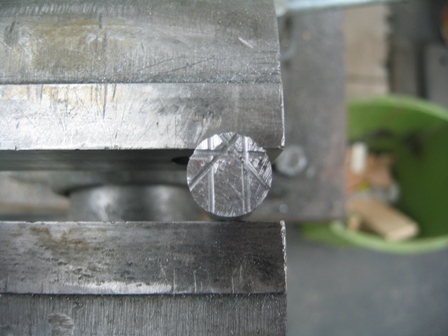Thanks for that explanation and the excellent photos, George. I knew helicopters were a joke, but I never realized a piece of steel could be so flexible.
Well we are finally getting under way with the nano-cannon. The photos below pretty much tell the story. Our premise is: Anyone with a few simple tools can make a small, cute and surprisingly fun to shoot, cannon. For this project we are foregoing mills, lathes(conventional lathes), bandsaws, etc., etc.
This one is parked in front of the Connecticut State Armory in Hartford, CT. The dimension tags show full size and nano size, which is a 56.5:1 scale. This is based on 10" Rodman bore to BB gun dia.bore, .177" dia.

This one shows the elevation sockets on the breech. Model 1861 caused a change from ratchets to sockets and there is no preponderance either.

This photo is also of a 10" Rodman in Ft Knox, Maine and it shows the lower style, Casemate carriage which we will make.

To make the piece of scrap, .625" dia., low-carbon, rod fit in our drill chuck(3/8"), a few cuts with a hack saw, about 1/2" deep are made to shape the end to a multifaceted design that fits the chuck well.

This is a view of the entire electric drill lathe. Don't worry about side pressure which could wear out bearings. We are filing here, NOT cutting with a lathe tool. Don't forget to grease the tailstock center made from a piece of all-thread filed to a point shown at the left.

Another view showing the guide on the right.

Some necessary hand tools used are a center punch and four files. There are double-cut machine files, (fast cutting) and single-cut mill files,(slower cutting) files. Four grades of coarseness exist: coarse, bastard, second and smooth. The two large files are both doulble-cut, one a bastard and one a smooth. The small files are almost needle file size and are single-cut, one a mill second and one a mill smooth. After you shape with these, you can go right to 240 grit alox-cloth or wet and dry sandpaper.

This last photo shows the lathe set-up and ready for work; the dimension tagged photo-copy is nearby to keep the shape in view. Just five licks with that medium size, double-cut bastard machine file got rid of all the rust and reduced that .625" dia. down to about .610" dia. too. The largest scale dia. we need is .560" dia.near the vent.

We are cutting the tube thurs. night and will show a very simple method of checking the dimensional size of the tube as you remove metal with those files. You DO NOT need a pair of electronic calipers.
Regards,
Tracy and Mike